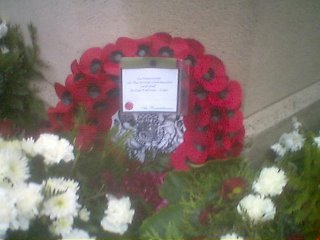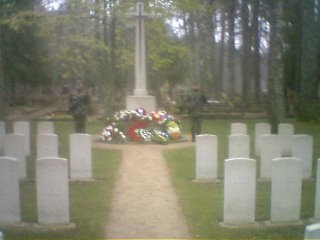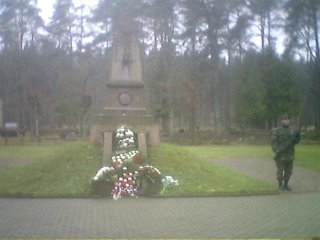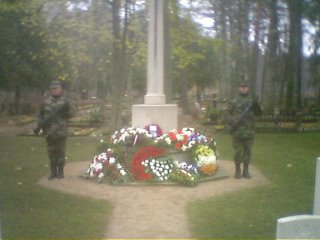Time to Remember

One of the more remarkable coincidences of life in Riga and the UK is that in both countries, and on the same day, November 11th, we remember the fallen soldiers, sailors and airman who have died on behalf of their country.
For the UK and Commonwealth countries the time of the 11th minute, on the 11th day of the 11th month, is related to the fact that on this precise time in 1918 the 1st World war guns fell silent.
In the case of Latvia on November 11th 1919 the Germans/Russians were defeated when they sought to capture Riga. This defeat ultimately led to the creation of the first independent Latvian State in 1921.
The day was named after the the Legendary Latvian hero Lacplesis, ( Part bear - part man) who according to legend some 700 years prior had helped defeat the Germans whenever they attacked Latvians. You can read more about this legendary character at :
http://www.balticsww.com/news/features/bear_slayer.htm
So on grey and gloomy Remembrance Sunday S.... ( Welsh) and I set off to visit the British War grave site in St Nikolay cemetery, near Jelgeva, where the bodies of 36 British soldiers and sailors are buried, who lost there lives fighting the Germans in order to liberate Latvia, for the Remembrance Sunday service.
There was of course one small snag, neither S..... or myself had ever been to this particular cemetery, so whilst finding Jelgava was easy - finding the cemetery could prove to be a little tricky.
However, God help diplomatic plates - as whilst on route to Jelgava, we were passed by 4 x4 with diplomatic plates - Aha we cried - follow that car ! - and we did - all the way into the Nestle petrol station into he middle of Jelgava.
It was at this point that doubts did creep into my mind - particularly as the reason for visiting the Nestle garage seemed to be to allow a lady passenger to visit the toilet.
But given that we had no other option ( we were lost !) we proceeded to follow said vehicle all around Jelgava and finally there it was the Cemetery, and we were early.
The service of remembrance was to commence at 10:30am, and for the next few minutes various dignitaries arrived
J..... ( Scottish - retired but still likes to play with trains)
J..... ( Australian/Latvian and a consulate to boot!)
I... B... ( claimed to be British ambassador)
and a whole host of military and civilian officials representing UK, America, Canada, Latvia

It was a very moving ceremony during which a number of wreaths were laid, and the names of the fallen were read out.
We then proceeded across the cemetery to the Latvian War Memorial, to again allow our respects to be paid to Latvians who had fallen. Again wreaths were laid by those countries represented at the ceremony.

At this point J.... ( Australian/Latvian) realised that he had left his wreath in the back of the car, as nobody had told him that the two war memorials were so close together !.
So having agreed that we would give the Jelgava Mayor's coffee and biscuits morning a miss, mainly because we had no idea how to get to his office, we retrieved the said wreath and J.... held his own personal act of remembrance.

I think for all who attended, a time for reflection, particularly when you realise that the average age of the British soldiers and sailors was mid twenties. How lucky we are , at least of my generation, not to have faced to horrors of a World War.
As ever on these occasions characters appear, in this case two are worthy of mention. The first and most illustrious was the Earl of Carlisle - what was he doing in Latvia ?
He reminded me of Michael Foote ( one time labour leader) who when attending a Remembrance Sunday Service in London, arrived wearing a duffel coat - it cost him the next General election. Well lets just say that the Earl will never win prizes for sartorial elegance.
For the interested here is his pedigree ( and yes they do call it that )
THE 13TH EARL OF CARLISLE, Viscount Howard of Morpeth, Northumberland, Lord Ruthven of Freeland, and Baron Dacre of Gillesland (George William Beaumont Howard); b 15 Feb 1949; s f 1994; educ Eton and Balliol Coll Oxford (MA); Maj 9th/12th Roy Lancers to 1987, fought (Lib Alliance) Easington 1987 gen election and (Lib Dem) Northumbria European party
and this from Burkes Peerage :
George William Beaumont Howard, 13th Earl of Carlisle (M)b. 15 February 1949,
#11520
Last Edited=10 May 2003
Consanguinity Index=0.0% ( prize for first person to describe what this is)
And finally a lady to whom we are all indebted - an American colonel, of diminutive stature ( she should meet J.... Irish). It was this lady who took it upon herself to remove R.. ( American soldier - who once cursed these shores).
Had the opportunity arose then I think I would have suggested that she be given the freedom of Riga.
I would like to think that all of those who have died will forgive us a little humour on what was and is a solemn occasion.
 On arrival back in Riga, we partook of a few beers in honour of those we had remembered, well at least S.... and I did. J.... (Scottish - plays with trains) went to play with the doctors and nurses at the ARS clinic - as he needed something "lanced" Ugh
On arrival back in Riga, we partook of a few beers in honour of those we had remembered, well at least S.... and I did. J.... (Scottish - plays with trains) went to play with the doctors and nurses at the ARS clinic - as he needed something "lanced" Ugh
What with England beating Australia, Scotland nearly beating Argentina and a group of cretins who have brought new meaning to the word, and I do not mean better - quite a weekend.


For those interested in the history of why the red poppy has become a symbol of rememberance read on
Poppies, by nature, appear in churned up soil, particularly soil with a high lime content, which makes it so relevant to the battlefield. They were first noted blooming around soldiers' fresh graves during the Napoleonic Wars.
But the poppy was immortalised in a poem In Flanders Fields by Canadian Medical Officer John McCrae, written in response to the horrors he experienced at Ypres in 1915.
The poem begins: '
In Flanders' fields the poppies blow,
Between the crosses row on row'
Moina Michael, an American War Secretary with the YMCA and a writer, was moved by McCrae's words. She was the first to wear a poppy in memory of those who lost their lives during the First World War.
Using a gift of 10 dollars, she bought 25 artificial poppies from a department store, which were then worn in memory of the dead at a YMCA conference in November 1918.
Attending the same conference was Frenchwoman Anne Guerin. She was already selling her own handmade poppies to raise money for children in Europe affected by the war, but after attending the conference she had the idea of selling poppies in Britain to raise funds for ex-servicemen and their dependants.
Poppies went on sale on the first ever Poppy Day – 11 November 1921. Major George Howson served on the Western Front in the Great War. After the war ended, Howson founded the Disabled Society and, with a grant of £2000 from the Unity Relief Fund, set up a small poppy factory in London with five ex-servicemen. Today, the factory employs 61 people and 70% are disabled and most of the employees are widows or widowers or dependants of the ex-service community.
1 Comments:
Hello,
I just wanted to say a big Thank you for this post and well- the whole of your blog which I really enjoy reading. I also attended the Ceremony at Jelgava and had a chuckle at some of your experiences .
I live in the UK but have visited Riga 3 times due to my interest in my Family History.
My Greatgrandfather was one of 9 killed in action during 1919 while serving aboard HMS Dragon at Riga.
Thanks to your blog I've been inspired to set up a website about HMS Dragon and start a blog myself.It's early days for both projects but I thought I would give you some credit and my thanks!!
I would like if possible to use one or 2 of your photos on my website and blog as I didn't get a chance to use my camera on the day.
I'll be back in Riga later this year and I'll look out for you!
Lu x
where-does-the-time-go.blogspot.com
ps By the way..I have nothing but praise for The Earl Of Carlisle who has been so useful with my Family Reseach.He did much of the research necessary to confirm the names of those killed in action and has pushed for there to be a permanent Memorial to those killed in action in the Baltic during the fight for Independence during 1918-20.
Thanks to him 2 plaques now bear these names, the first in Tallinn and the 2nd at Portsmouth Cathedral.A 3rd is due to be unveiled in Riga later this year.
Post a Comment
<< Home